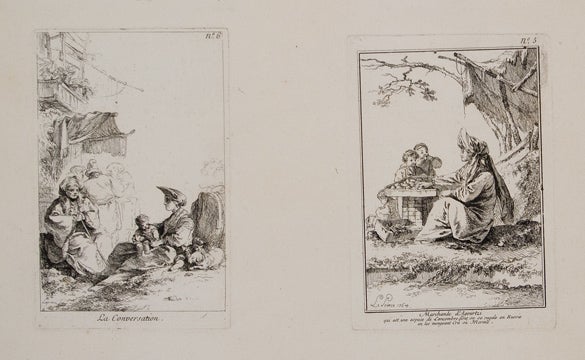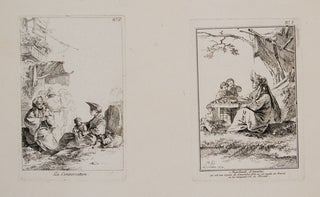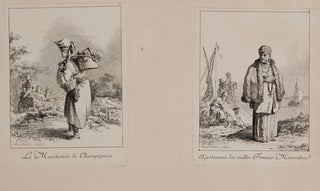Divers Habillements des Femmes de Moscovie.
LE PRINCE, Jean Baptiste. Divers Habillemens des Femmes de Moscovie. Dediée à M. de Lagrenée Peintre du roi, par son humble et très obéïssant Snr J.B. Le Prince. Complete suite of six numbered engravings on three sheets, signed "Le Prince 1764." Tipped-on and mounted on heavier paper, in window mats. Moscow: [1764]. WITH:
____________. IIe Suitte d'habillements des Femmes de Moscovie. Complete set of six numbered engraved plates on three sheets, signed "Le Prince 1768." Tipped-on and mounted on heavier paper, in window mats. Preserved in folding box of green paper over boards. Moscow: [1768].
Early issue of two suites from Le Prince's celebrated album of Russian Cries and Costume, which "constitute an important part of the pictorial record of the time" (Beall p. 485). Le Prince's Russian etchings became hugely popular and have been justly praised for their documentary as well as their artistic and aesthetic value.
Jean-Baptiste Le Prince (1734-1781) painter; draftsman and etcher, was the most famous student of François Boucher. Not only did Le Prince assume Boucher's controlled painting style, but he also adopted his master's penchant for rustic settings with shepherds and shepherdesses.
During 1750s Le Prince traveled extensively throughout Russia, filling sketchbooks with studies of the Russian people, with special emphasis on local customs and costumes. He returned to Paris in 1763 and began painting pictures and printing etchings of the Russian countryside and daily life. In 1765 the French Académie Royale exhibited fifteen paintings by Le Prince, all scenes of Russia. It has been noted that the artist used Russian costumes brought back to France from his travels and even small mannequins to create accurate rendering of dress and local type.
"Le Prince's graphic art of Russia and its peoples is significant in that he based his compositions entirely upon his own designs, lending a much more realistic portrayal to his views than other eighteenth-century contemporaries. He is also credited with being the first artist (in 1768) to introduce aquatint into his etched and engraved plates. He may even have been the inventor of aquatint" (J. Paul Getty Museum online). A few light spots, else very fine.
Not in Lipperheide. Colas 1841 & 1847. Ray, French I, 75-6. Cohen-Ricci 626.
Item nr. 122991
Price:
$6,500.00



